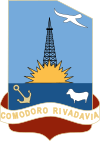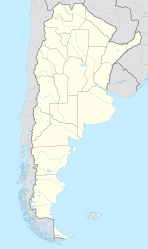Comodoro Rivadavia
| Comodoro Rivadavia | ||
|---|---|---|

Downtown Comodoro Rivadavia
|
||
|
||
| Nickname(s): The Capital of the Wind | ||
| Motto: A city with energy. | ||
| Coordinates: 45°51′53″S 67°28′51″W / 45.86472°S 67.48083°W | ||
| Country |
|
|
| Province |
|
|
| Department | Escalante Department | |
| Founded | 1901 | |
| Government | ||
| • Mayor | Néstor di Pierro | |
| Area | ||
| • Total | 548.2 km2 (211.7 sq mi) | |
| Elevation | 61 m (200 ft) | |
| Population (2010) | ||
| • Total | 182,631 | |
| • Density | 330/km2 (860/sq mi) | |
| Time zone | GMT (UTC-3) | |
| Post code | 9000 | |
| Climate | BSk | |
| Website | Official Website | |
Comodoro Rivadavia (Spanish pronunciation: [komoˈðoɾo riβaˈðaβja]) is a city in the Patagonian province of Chubut in southern Argentina, located on the San Jorge Gulf, an inlet of the Atlantic Ocean, at the foot of the Chenque Hill. Comodoro Rivadavia is the most important city of the San Jorge Basin.
The city is often referred simply as Comodoro. It was at one time the capital of Comodoro Rivadavia Territory, which existed from 1943 to 1955. The territory was a part of Chubut before and after its creation, and the city became the capital of Escalante Department. It had a population of 137,061 at the 2001 census [INDEC], and grew to 182,631 by the 2010 census.
Comodoro Rivadavia is a commercial and transportation center for the surrounding region, the largest city of Chubut, and an important export point for a leading Argentine petroleum district. A 1,770 km pipeline conveys natural gas from Comodoro Rivadavia to Buenos Aires.
Founded by decree on February 23, 1901, as a port for the inland settlement of Sarmiento, the first settler was Francisco Pietrobelli. Early settlers included Boers escaping British rule in South Africa, as well as Welsh settlers.
The town was named in honour of shipping minister Martín Rivadavia, a proponent of the development of Southern Argentina. It has been prosperous since 1907, when a drilling crew searching for water struck oil at a depth of 539 m.
...
Wikipedia


